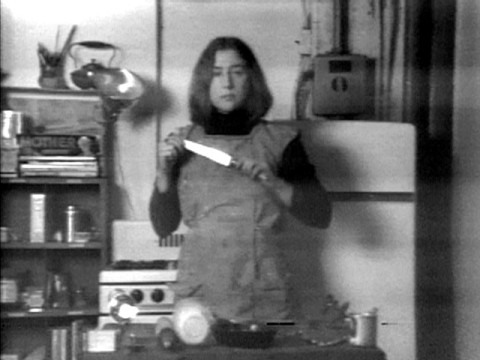Simultaneously a critic, photographer, video artist, and performance artist, American artist Martha Rosler examines the intersections of daily life and the public sphere in mass media, architecture, and urban environments. She also addresses a range of topics that include war, homelessness, transportation, and domesticity through an overtly feminist and political lens. For Rosler, art should be linked to public purpose and open dialogues concerning sociopolitical matters. Opposed to the commodification of art, her work also lacks a signature style and utilizes ephemeral media or forms that can be easily reproduced and distributed. Born in 1943 in Brooklyn N.Y., where she currently lives and works, Rosler received her B.A. from Brooklyn College in 1965, and her M.F.A. from the University of California, San Diego, in 1974. Her work has been exhibited and published widely, and she has earned several awards, including an Anonymous Was a Woman Award in 2007 and a Guggenheim Museum Lifetime Achievement Award in 2010.
Between 1967 and 1972, Rosler explored the ramifications of the Vietnam War as the first “living room war.” As Americans were able to watch live-action footage from the battlefields in the comfort their homes, Rosler responded with two series of photomontages originally intended to be photocopied and handed out as fliers during anti-war protests. Both the _Bringing the War Home: House Beautiful_ and _Bringing the War Home: In Vietnam_ series integrate documentary photographs of wounded soldiers and dead children into advertising images of idealized home interiors. In 1994, 2004, and 2008, Rosler reprised the series to address the wars in Iraq and Afghanistan and demonstrate how little had changed. She also analyzed the framing of gender roles in the media in another series of photomontages entitled _Beauty Knows No Pain, or Body Beautiful_ (1966–72). In that series, Rosler exposed strong relations between juxtaposed images from pornographic magazines directed toward a male audience and advertisements for lingerie and kitchen appliances intended for female consumers.
Rosler also explored the (in)effectiveness of documentary photography in her seminal works on homelessness. _The Bowery in Two Inadequate Descriptive Systems_ (1974–75) combines unpopulated black-and-white images of the Bowery, once a Manhattan skid row neighborhood, with slang words for drunkenness, such as “loopy,” “boozy,” and “out like a light.” Leaving the work open to interpretation, Rosler encourages the viewer to consider how the images and language inadequately describe dispossession. Likewise, _If You Lived Here…_ (1989), which included three exhibitions and a series of public events at the Dia Art Foundation in New York City, explored the far-reaching social and political complexities of homelessness.
She also explored the symbolism of transit and housing systems in photographs of empty airport terminals, a film of Corbusier’s last residential project, and _Utopia Station_ (2003), an investigation of the architectural designs and sociopolitical ramifications of Utopian communities that was created with a group of her students. Collaborative space was also a concern of _The Martha Rosler Library_ (2005–08). Rosler donated her extensive personal library for the traveling project wherein the collection simultaneously served as an exhibition, resource center, and meeting area in various international locations.
Rosler, however, remains best known for a six-minute video that she produced almost forty years ago. In the feminist milestone, _Semiotics of the Kitchen_ (1975), On a set resembling that of a cooking show, Rosler introduces several kitchen tools to the viewer in alphabetical order. She robotically names and mimes the use of the items, starting with an apron, a bowl, and a chopper and ending with a rolling pin, spoon, and tenderizer. To finish the alphabet, Rosler picks up the fork and knife to form the letters U to Z, the last of which she defiantly signs by slashing the knife through the air, as in the mark of Zorro. After her presentation of forceful and, at times, violent gestures that figure the instruments as weapons rather than kitchen gadgets, she ends the video with a comical shrug.
Rosler’s final gesture both eases the tension and underscores the ambivalent nature of the work. In other words, her juxtaposed farcical and belligerent mannerisms render the viewer uncertain whether to laugh or shudder in response. The video also emphasizes Rosler’s critical engagement with language, a system of signs she likens to housewifery. Just as the meanings of words are normalized, and not inherent, so are notions of social subjects. In the case of Semiotics, the cultural construction of the smiling middle-class white housewife has been largely defined by her domesticity. Rosler uses deadpan humor and references suppressed hostility to challenge those assigned meanings. Her demonstration of alternative ways of using and seeing cooking utensils is therefore also one of her unwavering commitment to use her artistic practice as a platform for social, cultural, and political questions. _—Kanitra Fletcher_

